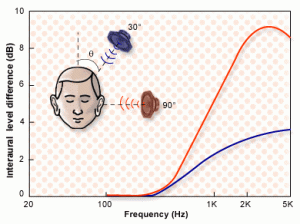 Sound and music are parts of our everyday life. Just as we have eyes to see, we also have ears to hear. We seldom take the time to consider the characteristics and behaviors of sound and how we hear. Sound is created when an object like a violin vibrates the air, and those vibrations travel through the air until they reach our ears. Our hearing works much like our vision. With two eyes, not only can we clearly see objects, we can also measure their distance from us. Likewise with hearing, we take a mono source and we hear it with stereo hearing so that we can measure it. Thus we are able to not only tell what the sound is, but also where it is and whether it is coming closer or moving away from us. Have you ever heard an airplane in the sky, and before you could see it, you already knew where it is coming from and what direction it is traveling in? That’s stereo hearing.
Sound and music are parts of our everyday life. Just as we have eyes to see, we also have ears to hear. We seldom take the time to consider the characteristics and behaviors of sound and how we hear. Sound is created when an object like a violin vibrates the air, and those vibrations travel through the air until they reach our ears. Our hearing works much like our vision. With two eyes, not only can we clearly see objects, we can also measure their distance from us. Likewise with hearing, we take a mono source and we hear it with stereo hearing so that we can measure it. Thus we are able to not only tell what the sound is, but also where it is and whether it is coming closer or moving away from us. Have you ever heard an airplane in the sky, and before you could see it, you already knew where it is coming from and what direction it is traveling in? That’s stereo hearing.
When you place two speakers in a room and play them, you divide that room into two pressure hemispheres, which immediately start to compete with one another. You find yourself listening to two girls, two guitars, and two trumpets, etc.., each one coming from each speaker – this is stereo sound. Your ears were never designed to hear stereo sound. In order for the sound to be pleasant and involving the speakers must work in the room together as one, and the pressure from each speaker must reach your ears in mono. In other words the girl singing from both of your speakers MUST arrive at your ears at the same time with the exact same pressure. Even a slight deviation from this will result in distortion. Although the distortion itself can be hard to detect, it does manifest itself in ways that you are familiar with:
- The speakers sound loud and aggressive. Ever wonder why your wife won’t sit and listen with you, or why she keeps telling you to turn it down? Women have far better hearing in high frequencies that men do, and since most of these distortions occur in the higher frequencies, it’s painful to them – It isn’t loud, it’s distorted!
- There is a very small “sweet spot” that you must be in. And if you move from this position the sound changes radically.
- The tone of the sound is uneven. The bass is boomy but only on certain frequencies, and the voices are shouty, bright, and harsh.
- Because distortion increases with more complex passages, you are left with is a system that is either too quiet to understand the dialogue or the small nuances in music, or far too loud and boomy during the important passages. You can’t watch a movie or listen to a piece of music without turning the volume up and down several times throughout the piece.
Anyone can sell and install a home theater or stereo system and get it to work (sort of). Unfortunately any home theater or stereo, even a very expensive one, that is not critically set up has no chance of disappearing and letting the emotion of the story or piece of music take you over. Then comes the classic scenario; you self-diagnose the problem and make plans to self-medicate by buying yet another piece of equipment that you’re sure this time will be the answer to it all. And, surprisingly enough, it isn’t.
The point is this: There are many high quality speakers on the market, all of which have the “potential” to thrill you like you have never dreamed of before, but if they are not critically setup in your home this will never happen. The finest guitar or piano in the world cannot make beautiful music unless it is tuned perfectly. Why then can ANYONE expect fine speakers to make wonderful music in your home without being critically set up?

Master Set™, the only systematic speaker setup method that works in every room with any system.
Visit us at Soundings for a dramatic demonstration of what Master Set™ can do for your home theater or home stereo system. Or to read more about Master Set™, click here.
